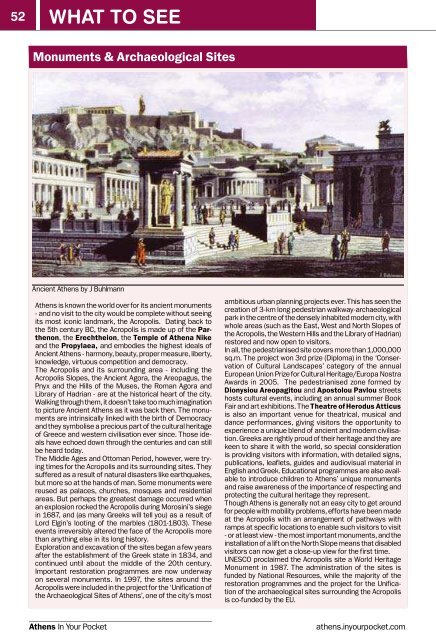Hotels Restaurants Cafés Nightlife Sightseeing Events Maps - KISADO
Hotels Restaurants Cafés Nightlife Sightseeing Events Maps - KISADO
Hotels Restaurants Cafés Nightlife Sightseeing Events Maps - KISADO
- No tags were found...
You also want an ePaper? Increase the reach of your titles
YUMPU automatically turns print PDFs into web optimized ePapers that Google loves.
52 What to seeWhat to see53Monuments & Archaeological SitesAncient Athens by J BuhlmannAthens is known the world over for its ancient monuments- and no visit to the city would be complete without seeingits most iconic landmark, the Acropolis. Dating back tothe 5th century BC, the Acropolis is made up of the Parthenon,the Erechtheion, the Temple of Athena Nikeand the Propylaea, and embodies the highest ideals ofAncient Athens - harmony, beauty, proper measure, liberty,knowledge, virtuous competition and democracy.The Acropolis and its surrounding area - including theAcropolis Slopes, the Ancient Agora, the Areopagus, thePnyx and the Hills of the Muses, the Roman Agora andLibrary of Hadrian - are at the historical heart of the city.Walking through them, it doesn’t take too much imaginationto picture Ancient Athens as it was back then. The monumentsare intrinsically linked with the birth of Democracyand they symbolise a precious part of the cultural heritageof Greece and western civilisation ever since. Those idealshave echoed down through the centuries and can stillbe heard today.The Middle Ages and Ottoman Period, however, were tryingtimes for the Acropolis and its surrounding sites. Theysuffered as a result of natural disasters like earthquakes,but more so at the hands of man. Some monuments werereused as palaces, churches, mosques and residentialareas. But perhaps the greatest damage occurred whenan explosion rocked the Acropolis during Morosini’s siegein 1687, and (as many Greeks will tell you) as a result ofLord Elgin’s looting of the marbles (1801-1803). Theseevents irreversibly altered the face of the Acropolis morethan anything else in its long history.Exploration and excavation of the sites began a few yearsafter the establishment of the Greek state in 1834, andcontinued until about the middle of the 20th century.Important restoration programmes are now underwayon several monuments. In 1997, the sites around theAcropolis were included in the project for the ‘Unification ofthe Archaeological Sites of Athens’, one of the city’s mostambitious urban planning projects ever. This has seen thecreation of 3-km long pedestrian walkway-archaeologicalpark in the centre of the densely inhabited modern city, withwhole areas (such as the East, West and North Slopes ofthe Acropolis, the Western Hills and the Library of Hadrian)restored and now open to visitors.In all, the pedestrianised site covers more than 1,000,000sq.m. The project won 3rd prize (Diploma) in the ‘Conservationof Cultural Landscapes’ category of the annualEuropean Union Prize for Cultural Heritage/Europa NostraAwards in 2005. The pedestrianised zone formed byDionysiou Areopagitou and Apostolou Pavlou streetshosts cultural events, including an annual summer BookFair and art exhibitions. The Theatre of Herodus Atticusis also an important venue for theatrical, musical anddance performances, giving visitors the opportunity toexperience a unique blend of ancient and modern civilisation.Greeks are rightly proud of their heritage and they arekeen to share it with the world, so special considerationis providing visitors with information, with detailed signs,publications, leaflets, guides and audiovisual material inEnglish and Greek. Educational programmes are also availableto introduce children to Athens’ unique monumentsand raise awareness of the importance of respecting andprotecting the cultural heritage they represent.Though Athens is generally not an easy city to get aroundfor people with mobility problems, efforts have been madeat the Acropolis with an arrangement of pathways withramps at specific locations to enable such visitors to visit- or at least view - the most important monuments, and theinstallation of a lift on the North Slope means that disabledvisitors can now get a close-up view for the first time.UNESCO proclaimed the Acropolis site a World HeritageMonument in 1987. The administration of the sites isfunded by National Resources, while the majority of therestoration programmes and the project for the Unificationof the archaeological sites surrounding the Acropolisis co-funded by the EU.Acropolis of Athens , MAcropolis, tel. 210 3210219.Set in a site covering 30,000 sq.m., the Acropolis of Athensis a perfect example of how ancient architecture was adaptedto a natural site to form what has become a model worldwideand down the ages. It was the ancient city’s most importantreligious centre and its monuments, (the Parthenon, theErechtheion, the Propylaea -the monumental entrance to theAcropolis- and the small Temple of Athena Nike) have becomean important symbol of ancient Greece’s bequest to Europeand the world.The first signs of occupation on the ‘sacredrock’ of the Acropolis date back to the Neolithic period (2ndmillennium BC). In Mycenaean times (1200-1100BC) it wasthe seat of the king, whose palace stood roughly where theErechtheion was built many centuries later. After the 11thcentury BC until the end of Antiquity, it was home to the cultof Athena, patron goddess of the city that took her name.There, Athena was worshipped at majestic temples, brilliantbuildings and a vast number of votive monuments. The mostrenowned were built in the second half of the 5th centuryBC, when Athens took a lead among the ancient world’s citystates, following important victories against the Persiansand the establishment of Democracy. In the golden age thatfollowed, thought and art flourished, and an exceptional groupof artists made the ambitious plans of Athenian statesmanPericles reality, under the guidance of the sculptor Pheidias.The most important monuments were built during that time:the Parthenon, built by Ictinos (447-432BC), the Erechtheion,with its shrines to Athena Polias and Poseidon-Erechtheus andthe porch adorned with the famous Caryatids hand-maidens(421-406BC), the Propylaea - the monumental entrance to theAcropolis designed by Mnesicles (437-431BC) - and the smalltemple of Athena Nike (421-407BC). QOpen 08:30 - 15:00.Admission: €12, Concessions: €6 (4 day pass).The Slopes of the Acropolis D6,D7,E7, The 70,000sq.m. archaeological site of the Slopes of the Acropolisextends around the Sacred Rock of the Acropolis. Afterthe Acropolis itself, the Slopes were the most importantreligious centre of ancient Athens. The sanctuary of DionysusEleuthereus on the South Slope, established in thewww.theotheracropolis.comThe Acropolis of Athens has been many things other thanwhat we have learned to believe. The collective behindthe ‘www.theotheracropolis.com’ project, tries to introduceus to the different faces, roles and identities of thesacred rock through the centuries. They want to take ourperception of the site away from the stereotypical touristexperience and “undermine the monolithic discourse onthe Acropolis as an exclusively classical site”.An extremely interesting photo blog worth checking outbefore the obligatory visit, especially for those who liketo go a bit deeper than the surface.6th Century BC, was the site of the Great or City Dionysiacelebrations. Here too was the theatre of Dionysus, one ofthe world’s most ancient theatres, where the works of the Aeschylus,Sophocles and Euripides were performed. The samearchaeological area is also home to the Odeion of Pericles,ancient Athens’ first roofed building for musical contests,the sanctuary of the healing god Asklepius founded in the5th century BC, the Stoa given to the city in 160 B.C. by theking of Pergamon, Eumenes II, various monuments donatedby sponsors of theatrical performances such as the Monumentof Lysicrates, and the Odeion of Herodus Atticus, builtin the 2nd century AD. With the predominance of Christianity,especially during the 5th century AD, many buildings on theSouth Slope were reconsecrated as Christian monuments.The East Slope is dominated by the cave of Aglauros, wherethe Athenian youths (ephebes) took the oath to protect thesanctuaries and sacred institutions of the city. One of themost important monuments of the North Slope is the springof Klepsydra, in front of which ran the last section of thePanathenaic Way. On this side of the rock there are three cavesanctuaries dedicated to the cults of Pan, Zeus and Apollo, thecave with the Mycenaean spring, the sanctuary of Aphroditeand Eros and the Medieval church of Saint Nicolas.The Erechtheion on the Acropolis Rock. The Caryatids are replicas of the original ones housed in the new MuseumAthens In Your Pocketathens.inyourpocket.com athens.inyourpocket.com February - March 2010








